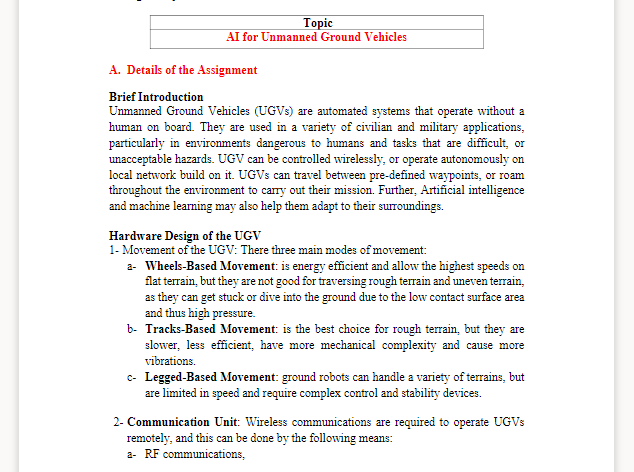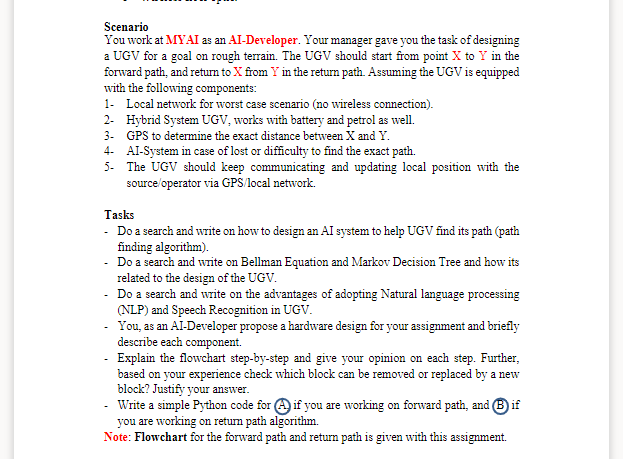Please answer this! even if you count it as multiple posts, I don't mind!
Brief Introduction Unmanned Ground Vehicles (UGVs) are automated systems that operate without a human on board.
They are used in a variety of civilian and military applications, particularly in environments dangerous to humans and tasks that are difficult, or unacceptable hazards.UGV can be controlled wirelessly, or operate autonomously on local network build on it. UGVs can travel between pre-defined waypoints, or roam throughout the environment to carry out their mission. Further, Artificial intelligence and machine learning may also help them adapt to their surroundings.Hardware Design of the UGV1-Movement of the UGV: There three main modes of movement:a-Wheels-Based Movement: is energy efficient and allow the highest speeds on flat terrain, but they are not good for traversing rough terrain and uneven terrain, as they can get stuck or dive into the ground due to the low contact surface area and thus high pressure.b-Tracks-Based Movement: is the best choice for rough terrain, but they are slower, less efficient, have more mechanical complexity and cause more vibrations.c-Legged-Based Movement: ground robots can handle a variety of terrains, but are limited in speed and require complex control and stability devices.2-Communication Unit:Wireless communications are required to operate UGVs remotely, and this can be done by the following means:a-RF communications,
3b-Satellite links, c-Wireless fiber optic. ScenarioYou work at MYAIas an AI-Developer. Your manager gave you the task of designing a UGV for a goal on rough terrain. The UGV should start from point X to Y in the forward path, and return to X from Y in the return path. Assuming the UGV is equipped with the following components:1-Local network for worst case scenario (no wireless connection). 2-Hybrid SystemUGV, works with battery and petrol as well. 3-GPS to determine the exact distance between X and Y.4-AI-System in case of lost or difficulty to find the exact path.5-The UGV should keep communicating and updating local position with the source/operatorvia GPS/local network. Tasks-Do a searchand writeon how to design an AI system to help UGV find its path (path finding algorithm).-Do a search and write on Bellman Equation and Markov Decision Tree and how its related to the design of the UGV.-Do a search and write on the advantages of adopting Natural language processing(NLP)and Speech Recognition in UGV.-You, as an AI-Developer propose a hardware design for your assignment and briefly describe each component. -Explain the flowchart step-by-step and give your opinion on each step. Further, based on your experience check which block can be removed or replaced by a new block? Justify your answer.-Write asimple Python code for A, if you are working on forward path, and B if you are working on return path algorithm. Note:Flowchart for the forward path and return path is given with this assignment.



Topic AI for Unmanned Ground Vehicles A. Details of the Assignment Brief Introduction Unmanned Ground Vehicles (UGVs) are automated systems that operate without a human on board. They are used in a variety of civilian and military applications, particularly in environments dangerous to humans and tasks that are difficult, or unacceptable hazards. UGV can be controlled wirelessly, or operate autonomously on local network build on it. UGVs can travel between pre-defined waypoints, or roam throughout the environment to carry out their mission. Further, Artificial intelligence and machine learning may also help them adapt to their surroundings. Hardware Design of the UGV 1- Movement of the UGV: There three main modes of movement: 2- Wheels-Based Movement: is energy efficient and allow the highest speeds on flat terrain, but they are not good for traversing rough terrain and uneven terrain, as they can get stuck or dive into the ground due to the low contact surface area and thus high pressure. b- Tracks-Based Movement: is the best choice for rough terrain, but they are slower, less efficient, have more mechanical complexity and cause more vibrations. C- Legged-Based Movement: ground robots can handle a variety of terrains, but are limited in speed and require complex control and stability devices. 2- Communication Unit: Wireless communications are required to operate UGVs remotely, and this can be done by the following means: 2- RF communications, Scenario You work at MYAI as an AI-Developer. Your manager gave you the task of designing a UGV for a goal on rough terrain. The UGV should start from point X to Y in the forward path, and return to X from Y in the return path. Assuming the UGV is equipped with the following components: 1. Local network for worst case scenario (no wireless connection). 2- Hybrid System UGV, works with battery and petrol as well. 3. GPS to determine the exact distance between X and Y. 4. Al-System in case of lost or difficulty to find the exact path. 5. The UGV should keep communicating and updating local position with the source/operator via GPS/local network. Tasks - Do a search and write on how to design an AI system to help UGV find its path (path finding algorithm). Do a search and write on Bellman Equation and Markov Decision Tree and how its related to the design of the UGV. Do a search and write on the advantages of adopting Natural language processing (NLP) and Speech Recognition in UGV. - You, as an Al-Developer propose a hardware design for your assignment and briefly describe each component. Explain the flowchart step-by-step and give your opinion on each step. Further, based on your experience check which block can be removed or replaced by a new block? Justify your answer. - Write a simple Python code for if you are working on forward path, and 6 if you are working on retum path algorithm. Note: Flowchart for the forward path and return path is given with this assignment. B. Structure of the Report: You are required to write an engineering technical report to cover all the points mentioned in the given scenario. There is no restriction on the number of pages of the report! Write so that, as an AI developer, you feel you've covered all the points in detail. Your report should include the following points: Title: propose a title for your report! Introduction: Introduction related to the selected topic. Methodology: In this part you need to give all related mathematical formula, figures and practical applications, flowchart, and other methods. * Discussion Discuss the results, if any, using your opinion. Conclusions: Conclude your work. * Future work: A brief discussion on some future works related to your selected topic. 3 References: Must always be included. Appendices: Including supporting material, such as descriptions of hardware components. Topic AI for Unmanned Ground Vehicles A. Details of the Assignment Brief Introduction Unmanned Ground Vehicles (UGVs) are automated systems that operate without a human on board. They are used in a variety of civilian and military applications, particularly in environments dangerous to humans and tasks that are difficult, or unacceptable hazards. UGV can be controlled wirelessly, or operate autonomously on local network build on it. UGVs can travel between pre-defined waypoints, or roam throughout the environment to carry out their mission. Further, Artificial intelligence and machine learning may also help them adapt to their surroundings. Hardware Design of the UGV 1- Movement of the UGV: There three main modes of movement: 2- Wheels-Based Movement: is energy efficient and allow the highest speeds on flat terrain, but they are not good for traversing rough terrain and uneven terrain, as they can get stuck or dive into the ground due to the low contact surface area and thus high pressure. b- Tracks-Based Movement: is the best choice for rough terrain, but they are slower, less efficient, have more mechanical complexity and cause more vibrations. C- Legged-Based Movement: ground robots can handle a variety of terrains, but are limited in speed and require complex control and stability devices. 2- Communication Unit: Wireless communications are required to operate UGVs remotely, and this can be done by the following means: 2- RF communications, Scenario You work at MYAI as an AI-Developer. Your manager gave you the task of designing a UGV for a goal on rough terrain. The UGV should start from point X to Y in the forward path, and return to X from Y in the return path. Assuming the UGV is equipped with the following components: 1. Local network for worst case scenario (no wireless connection). 2- Hybrid System UGV, works with battery and petrol as well. 3. GPS to determine the exact distance between X and Y. 4. Al-System in case of lost or difficulty to find the exact path. 5. The UGV should keep communicating and updating local position with the source/operator via GPS/local network. Tasks - Do a search and write on how to design an AI system to help UGV find its path (path finding algorithm). Do a search and write on Bellman Equation and Markov Decision Tree and how its related to the design of the UGV. Do a search and write on the advantages of adopting Natural language processing (NLP) and Speech Recognition in UGV. - You, as an Al-Developer propose a hardware design for your assignment and briefly describe each component. Explain the flowchart step-by-step and give your opinion on each step. Further, based on your experience check which block can be removed or replaced by a new block? Justify your answer. - Write a simple Python code for if you are working on forward path, and 6 if you are working on retum path algorithm. Note: Flowchart for the forward path and return path is given with this assignment. B. Structure of the Report: You are required to write an engineering technical report to cover all the points mentioned in the given scenario. There is no restriction on the number of pages of the report! Write so that, as an AI developer, you feel you've covered all the points in detail. Your report should include the following points: Title: propose a title for your report! Introduction: Introduction related to the selected topic. Methodology: In this part you need to give all related mathematical formula, figures and practical applications, flowchart, and other methods. * Discussion Discuss the results, if any, using your opinion. Conclusions: Conclude your work. * Future work: A brief discussion on some future works related to your selected topic. 3 References: Must always be included. Appendices: Including supporting material, such as descriptions of hardware components









